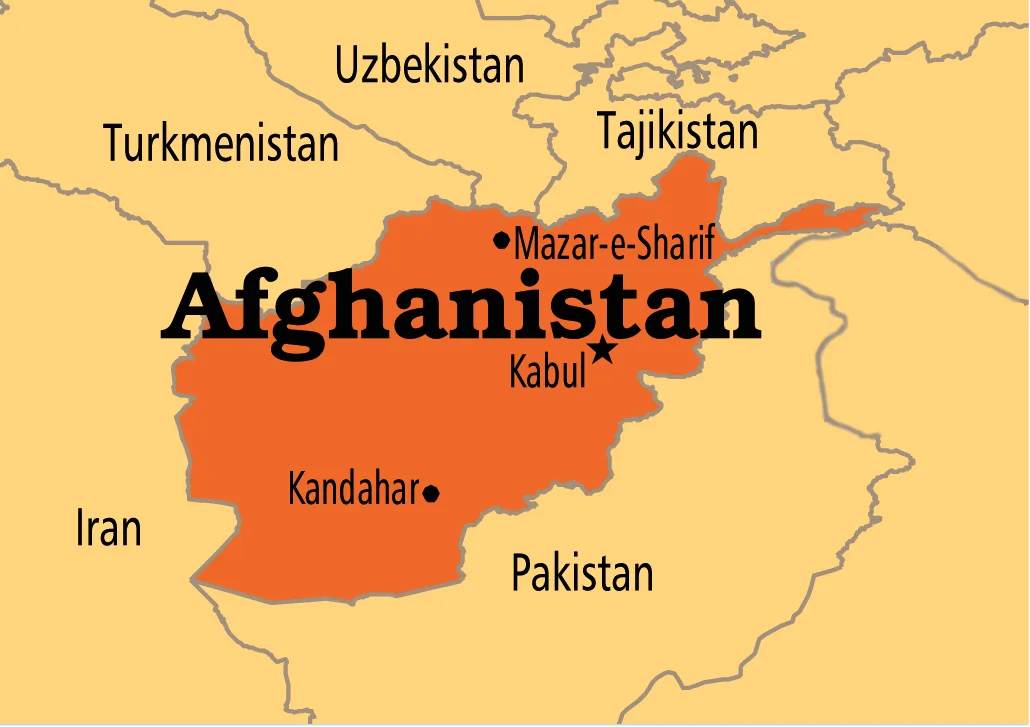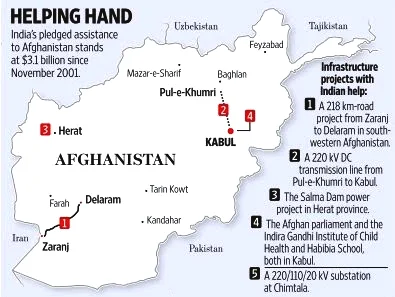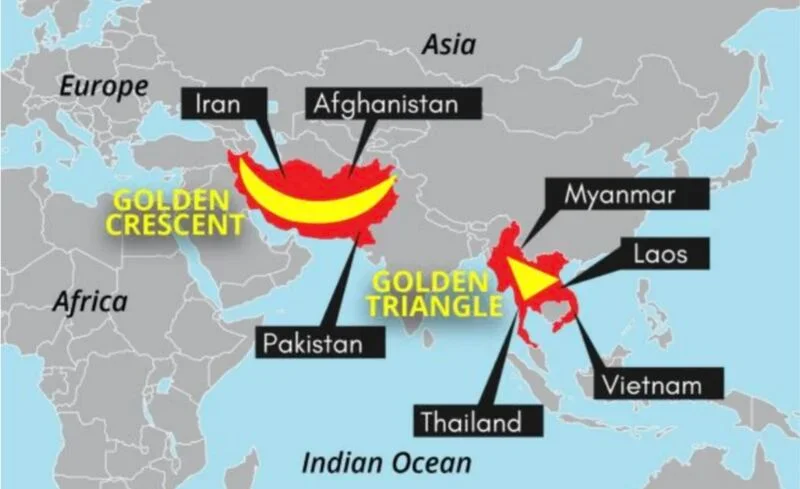International Relations
Strengthening India- Afghanistan Ties
This editorial is based on “ Talking to Taliban: On India-Afghanistan ties,” which was published in The Hindu on 14/10/2025. The article examines India’s measured engagement with the Taliban through the visit of Afghanistan’s Acting Foreign Minister, weighing strategic, security, and humanitarian priorities alongside ethical and regional diplomatic considerations.
For Prelims: Taliban, Northern Alliance, Salma Dam, Chabahar Port, Golden Crescent, Act East Policy, Heart of Asia, SCO, Moscow Format
For Mains: Recent Developments in India-Afghanistan Relations, Significance of India-Afghanistan Relations, Major Challenges facing India-Afghanistan Relations
India’s diplomatic engagement with the Taliban marks a critical juncture in regional geopolitics. The visit of Afghanistan’s Acting Foreign Minister signals New Delhi’s pragmatic approach to safeguarding strategic interests, security, and humanitarian commitments, even as ethical dilemmas and historical mistrust loom large. Balancing the need for regional stability, protection of investments, and human rights advocacy presents a complex challenge, testing India’s capacity for nuanced diplomacy in a volatile and rapidly evolving South Asian landscape.
What are the Recent Developments in India-Afghanistan Relations?
- Direct Diplomatic Engagement with the Taliban-led Government: The visit of Afghan Acting Foreign Minister Amir Khan Muttaqi marked the first direct diplomatic engagement with the Taliban-led government since 2021, signalling thawing ties and enhanced dialogue.
- The UN Security Council’s Sanctions Committee lifted travel restrictions on Muttaqi, enabling his visit, indicating international diplomatic accommodation.
- Upgrade of Indian Mission in Kabul: India and Afghanistan agreed on mutual exchanges of diplomats, facilitating continuous diplomatic communication.
- Transition from a technical mission to a full-fledged embassy demonstrates India’s intent to deepen diplomatic presence and official recognition steps.
- Commitments on Sovereignty and Security: Both nations affirmed respect for sovereignty and territorial integrity, with Afghanistan pledging not to permit use of its soil against India, a crucial security reassurance.
- Enhanced Trade Relations: Both governments are committed to boosting bilateral trade, aiming to rejuvenate economic ties despite political uncertainties.
- Both sides welcomed the commencement of the India-Afghanistan Air Freight Corridor, which will further enhance direct trade and commerce between the two countries.
- Humanitarian and Development Initiatives: India announced infrastructure projects, including hospital construction and extended humanitarian aid, reflecting soft power and developmental diplomacy.
- India expressed willingness to assist the Afghan government in reconstructing residential buildings in earthquake-affected areas.
What is the Significance of India-Afghanistan Relations?
- Strategic Geopolitical Partnership: India considers Afghanistan vital for regional security and countering adversarial influence, particularly Pakistan’s.
- Deterioration in Afghan-Pakistan relations influenced India’s strategic calculus for engaging the Taliban as a counterbalance to Pakistan’s regional influence
- India’s support for the Northern Alliance in the 1990s and its role as one of Afghanistan’s largest regional development partners showcase a long-term strategic commitment.
- Counterterrorism Collaboration: Post-2001, India actively engaged in capacity building of Afghan security forces to prevent Afghanistan from becoming a terror hub.
- The recent pledge by the Taliban-led Afghan government not to allow the use of Afghan soil against India marks evolving counterterrorism cooperation amid shifting realities.
- Development and Reconstruction Contributions: India has invested heavily in infrastructure projects: Salma Dam, Zaranj-Delaram highway (strategic trade route bypassing Pakistan), Kabul’s parliament building, hospitals, and power substations, showing India’s commitment to Afghan development as a form of soft power.
- Initiatives such as humanitarian assistance during droughts and COVID-19 exemplify India’s commitment to Afghan development.
- Economic and Trade Connectivity: With Afghanistan’s mineral wealth valued between $1-3 trillion, India sees economic opportunities in mining and trade.
- Enables India to participate in regional forums and infrastructure projects such as Chabahar Port (Iran-Afghanistan-India corridor) to bypass Pakistan and facilitate trade.
- Deep Rooted Cultural Bonds: India and Afghanistan share deep-rooted historical, cultural, and civilizational ties dating back to ancient times, reflected in shared religions, languages, and cultural exchanges.
- Bollywood’s popularity in Afghanistan and Indian scholarships for Afghan students highlight ongoing cultural diplomacy.
- Diplomatic Engagement Amid Political Shifts: India’s recent diplomatic outreach to Taliban-led Afghanistan—including upgrading its Kabul mission to full embassy status and hosting Taliban diplomats—demonstrates pragmatic diplomacy balancing recognition hesitancy with ground realities.
- India-Afghanistan ties counterbalance China’s growing Central Asian influence and Pakistan’s destabilizing activities. India’s participation in regional forums like the Heart of Asia – Istanbul Process further reinforces its role in promoting political cooperation and regional connectivity.
What are the Major Challenges Facing India-Afghanistan Relations?
- Security Concerns and Terrorism: Despite diplomatic engagement, terrorism remains a grave challenge.
- The Taliban’s historic links with terrorist groups like Lashkar-e-Taiba and Jaish-e-Mohammed raise fears of Afghanistan serving as a safe haven for anti-India militants.
- Although the Taliban pledged in 2025 not to allow Afghan soil to be used against India, scepticism persists due to incomplete disengagement from terror outfits.
- Pakistan’s Influence and Proxy Dynamics: Pakistan’s strategic rivalry with India plays out deeply in Afghanistan.
- Pakistan’s Inter-Services Intelligence (ISI) has historically supported the Taliban and proxy groups, complicating peace and security.
- The Taliban’s refusal to crack down on Tehrik-i-Taliban Pakistan (TTP), who wage insurgency in Pakistan, has soured Afghan-Pakistan ties but remains a risk for cross-border instability.
- Political Instability and Governance Issues: The Taliban’s non-democratic regime conflicts with India’s support for an inclusive, Afghan-led political process.
- Lack of women’s rights, minority protections, and suppression of dissent undermine India’s values-based engagement.
- The 2025 controversy over the exclusion of women journalists at Taliban-led press events in India exemplifies the difficulties of engaging a regime with a poor human rights record.
- Economic and Infrastructure Challenges: Afghanistan remains one of the world’s poorest countries.
- Security concerns impede India’s multiple investment projects, such as the Salma Dam and the Kabul parliament.
- The Taliban’s governance and international sanctions create hurdles in project continuity and trade. However, India’s push to trade via Chabahar port and mining sector invitations suggest cautious optimism.
- Growing Chinese Influence: China’s expanding role in Afghanistan, including dialogue with the Taliban and infrastructure investments, presents a strategic challenge for India.
- The evolving China-Afghanistan-BRI nexus presents a strategic challenge for India by potentially consolidating Beijing’s control over vital resource corridors and regional connectivity, thereby limiting India’s leverage in South Asia’s geopolitics.
- Drug Trafficking and Narcotics: Afghanistan’s position as the world’s largest opium producer, forming the core of the Golden Crescent (Afghanistan, Iran, Pakistan), fuels regional instability.
- The narcotics trade harms India, especially regions like Punjab, facing drug addiction crises, and finances terrorist activities.
- Controlling drug trafficking from the Golden Crescent remains a cross-border security priority, complicating bilateral ties.
What Strategic Steps Should India Take to Strengthen ties with Afghanistan?
- Sustain Diplomatic Engagement while Withholding Full Recognition: Following its pragmatic 2021 “engage but not recognise” policy post-Taliban takeover, India upgraded its technical mission to a full embassy in Kabul in 2025.
- India should continue to maintain and deepen official channels (full embassy, regular diplomatic exchanges) without immediate political recognition.
- Maintaining limited engagement and providing humanitarian aid rather than formal recognition, India should demonstrate that strategic necessity need not override moral responsibility, ensuring its actions remain both pragmatic and principled.
- Expand Targeted Development & Humanitarian Diplomacy: India should continue to counter the rising Chinese influence by expanding capacity-building aid, infrastructure cooperation, and diplomatic engagement, maintaining strategic autonomy—a principle highlighted in India’s foreign policy doctrines like “Act East” and “Neighbourhood First.”
- India should continue visible, needs-based projects (health, water, education, reconstruction) that build goodwill and stabilise communities.
- India is resuming and expanding several healthcare and infrastructure projects: construction of a 30-bed hospital in Kabul’s Bagrami district, Oncology & Trauma Centres, five maternity clinics in provinces like Paktika and Khost, and establishment of a Thalassemia Centre.
- These initiatives build soft power, foster goodwill, and stabilise local communities through development diplomacy—a model seen in Japan’s aid to Southeast Asia.
- Strengthen Counter-terrorism Cooperation: Institutionalise real-time intelligence exchange, joint investigations, and capacity building for Afghan security services within legal safeguards.
- Strengthen cross-border anti-narcotics collaboration, interdiction, and demand-reduction programmes in source and transit zones of the Golden Crescent.
- Drawing from the 2011 Strategic Partnership Agreement, India should continue to support Afghan security capacity-building programs, reflecting international best practices for counterterrorism cooperation.
- Secure Economic Connectivity & Geoeconomic Options: Expand trade and investment via alternative routes and projects that bypass hostile transit and pursue resource-sector partnerships with clear safeguards.
- For instance, Economic engagement through the use of Chabahar Port, resumption of the India-Afghanistan Air Freight Corridor (2025), and selective investments (e.g., Hajigak via AFISCO) with contractual and security guarantees provide mutual incentives for stability and create leverage for India.
- Multilateral & Regional Cooperation to Share Burden and Legitimacy: Work through Heart of Asia, SCO, Moscow Format, UN and partner countries (Iran, Central Asian states) for coordinated aid, counterterror, and reconstruction plans.
- These platforms enable coordinated humanitarian responses, counterterrorism, and cross-border cooperation, reflecting principles of multilateral conflict resolution embodied by the UN and ASEAN practices.
- Advocacy for Social, Gender, and Human Rights Concerns: Though engaging pragmatically, India has consistently advocated for women’s education, minority rights, and political inclusivity via diplomatic channels and international forums.
- The exclusion of women journalists during the 2025 Taliban visit to India sparked criticism but underscored India’s challenge to balance ethical concerns with diplomacy.
- India’s engagement strategy may resemble EU’s cautious diplomacy with countries under authoritarian rule, where aid is conditional on reforms.
- At the same time, India should continue to expand scholarships, vocational training, cultural exchanges, and media/communication outreach that reach ordinary Afghans.
Conclusion:
India-Afghanistan relations today reflect strategic pragmatism blended with deep historical ties. As Harsh Pant(Foreign Policy Expert) observes, “Engagement does not equate to endorsement,” highlighting India’s delicate balance between principled concerns and realpolitik. The path forward demands patient, principled engagement, robust humanitarian aid, and multilateral collaboration to safeguard India’s interests while supporting Afghanistan’s peace and progress.
|
Drishti Mains Question: Engaging the Taliban requires balancing principled diplomacy and realpolitik. In this context, discuss India’s Afghanistan policy and its impact on national security and global geopolitics. |
Frequently Asked Questions (FAQs)
Q1.What were the key recent developments in India–Afghanistan ties (2025)?
Taliban FM visit, UN sanctions waiver, Kabul mission upgraded, mutual diplomatic exchanges, pledges on sovereignty/security, and commitments on trade and humanitarian aid
Q2.Why are India–Afghanistan relations strategically important?
Provides strategic depth, counterterrorism cooperation, development diplomacy, and geoeconomic access via Chabahar and mining.
Q3. What are the major challenges in engaging the Taliban-led Afghanistan?
Terrorism, Pakistan’s proxy influence, human-rights issues, Chinese BRI presence, Golden Crescent drug trade, and project continuity risks.
Q4. What strategic measures should India adopt to strengthen ties with Afghanistan?
Engage without recognition, expand development & humanitarian aid, strengthen counterterror & intelligence sharing, secure trade routes, and pursue multilateral cooperation.
UPSC Civil Services Examination, Previous Year Questions (PYQs)
Prelims
Q. Consider the following countries: (2022)
- Azerbaijan
- Kyrgyzstan
- Tajikistan
- Turkmenistan
- Uzbekistan
Which of the above have borders with Afghanistan?
(a) 1, 2 and 5 only
(b) 1, 2, 3 and 4 only
(c) 3, 4 and 5 only
(d) 1, 2, 3, 4 and 5
Ans: (c)
Mains
Q. The proposed withdrawal of the International Security Assistance Force (ISAF) from Afghanistan in 2014 is fraught with major security implications for the countries of the region. Examine in light of the fact that India is faced with a plethora of challenges and needs to safeguard its own strategic interests. (2013)







